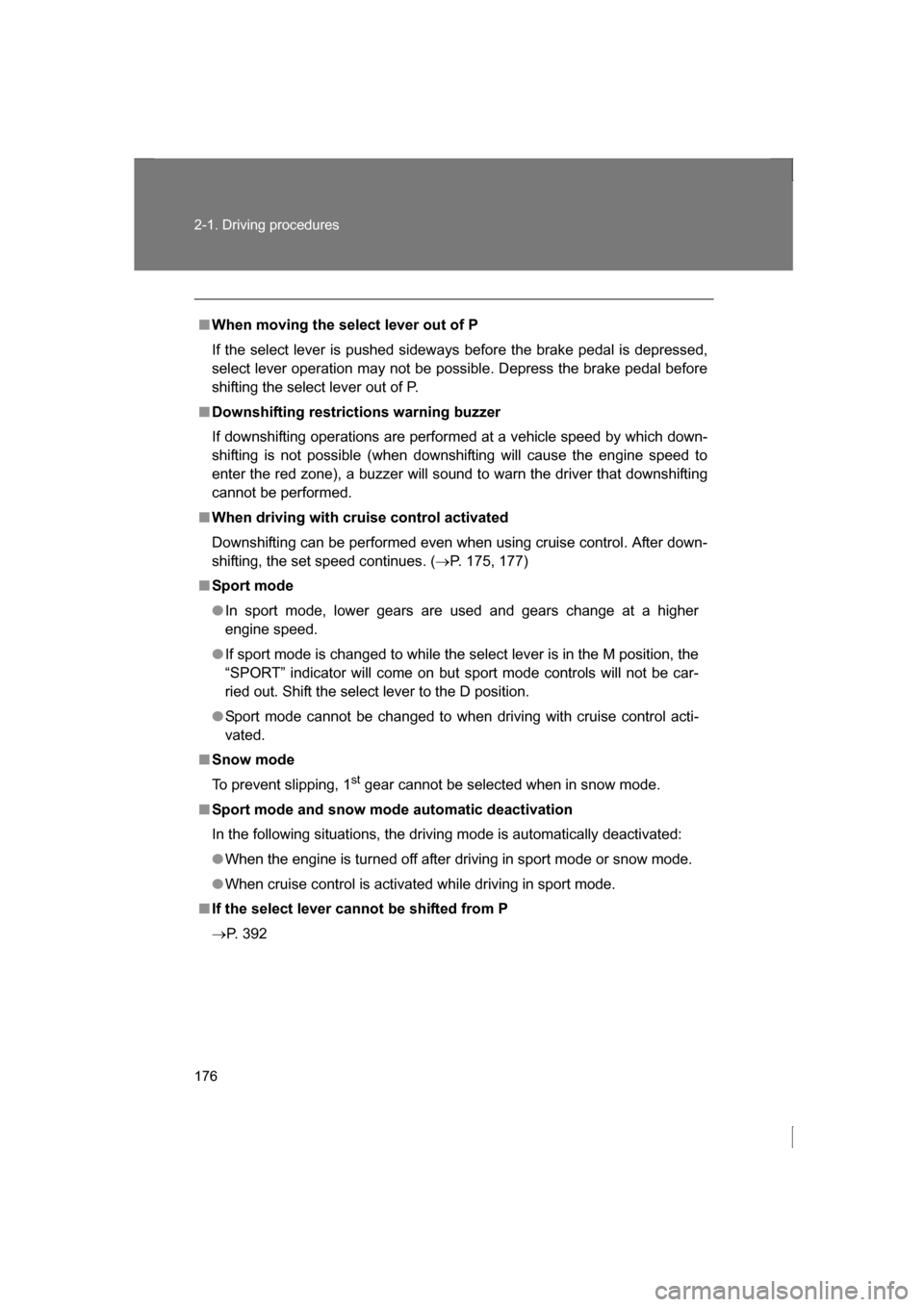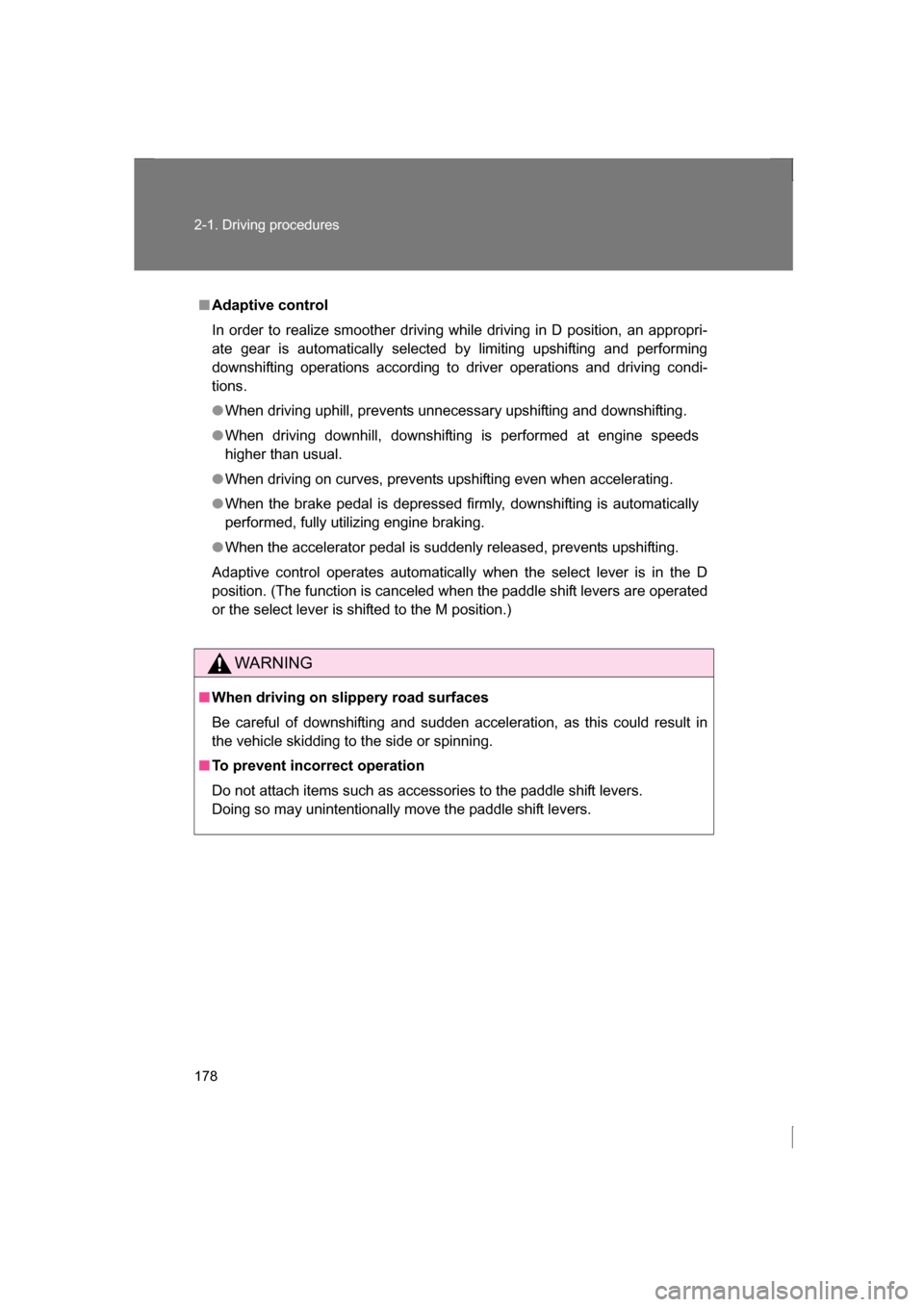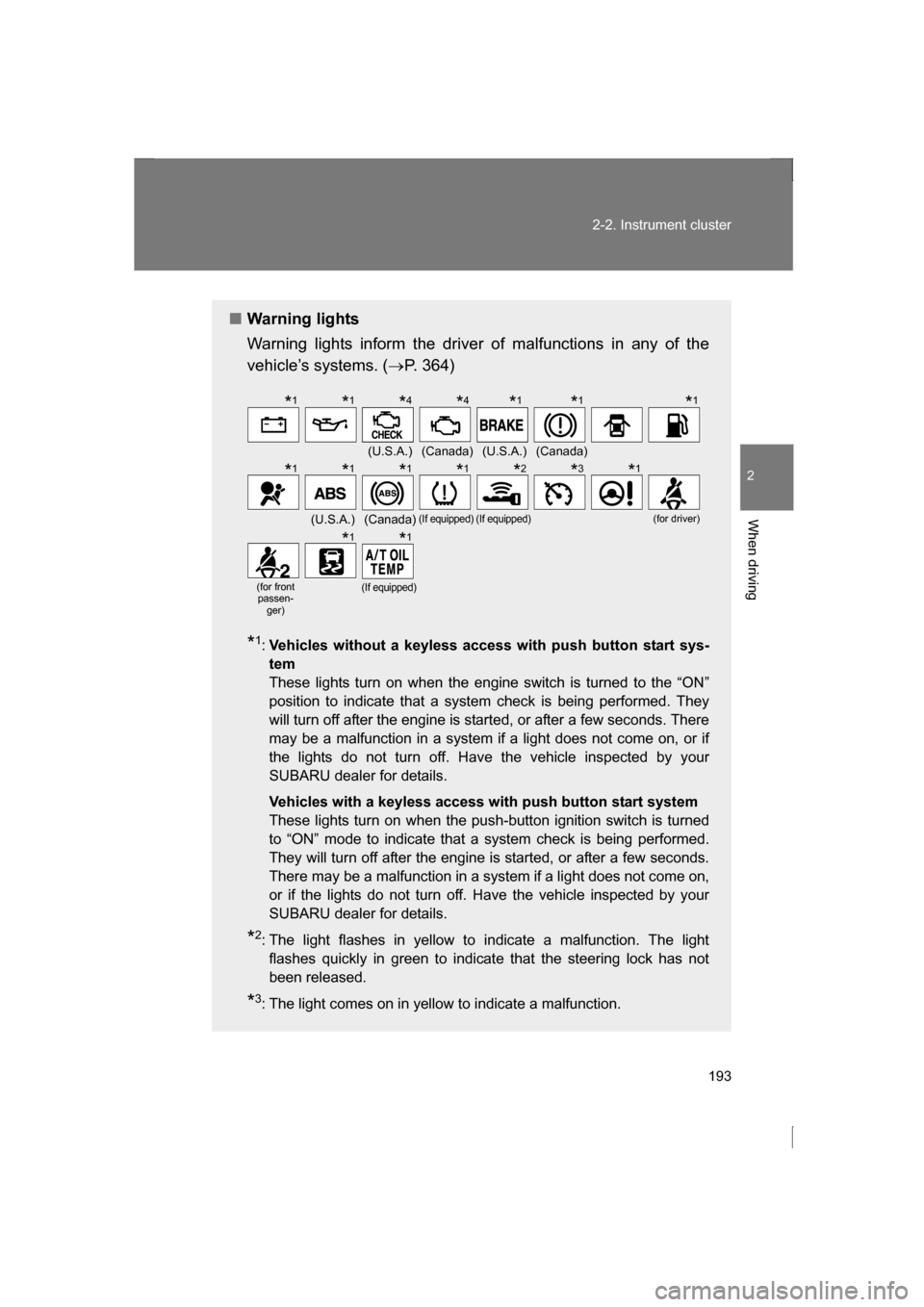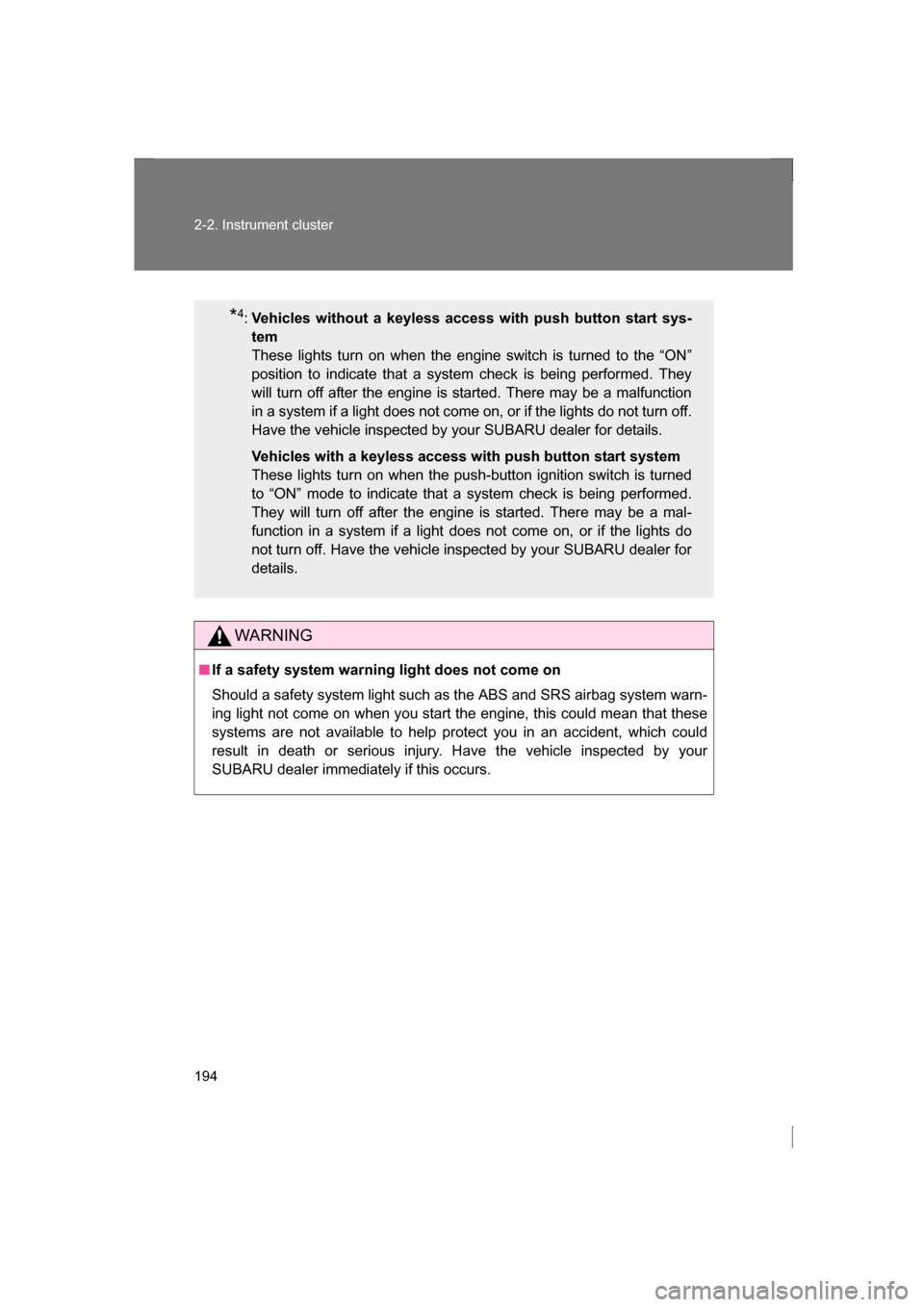Page 176 of 484

176
2-1. Driving procedures
■When moving the select lever out of P
If the select lever is pushed sideways before the brake pedal is depressed,
select lever operation may not be possible. Depress the brake pedal before
shifting the select lever out of P.
■Downshifting restrictions warning buzzer
If downshifting operations are performed at a vehicle speed by which down-
shifting is not possible (when downshifting will cause the engine speed to
enter the red zone), a buzzer will sound to warn the driver that downshifting
cannot be performed.
■When driving with cruise control activated
Downshifting can be performed even when using cruise control. After down-
shifting, the set speed continues. (→P. 175, 177)
■Sport mode
●In sport mode, lower gears are used and gears change at a higher
engine speed.
●If sport mode is changed to while the select lever is in the M position, the
“SPORT” indicator will come on but sport mode controls will not be car-
ried out. Shift the select lever to the D position.
●Sport mode cannot be changed to when driving with cruise control acti-
vated.
■Snow mode
To prevent slipping, 1 st
gear cannot be selected when in snow mode.
■Sport mode and snow mode automatic deactivation
In the following situations, the driving mode is automatically deactivated:
●When the engine is turned off after dr iving in sport mode or snow mode.
●When cruise control is activated while driving in sport mode.
■If the select lever cannot be shifted from P
→P. 392
Page 178 of 484

178
2-1. Driving procedures
■Adaptive control
In order to realize smoother driving while driving in D position, an appropri-
ate gear is automatically selected by limiting upshifting and performing
downshifting operations according to driver operations and driving condi-
tions.
●When driving uphill, prevents unnecessary upshifting and downshifting.
●When driving downhill, downshift ing is performed at engine speeds
higher than usual.
●When driving on curves, prevents upshifting even when accelerating.
●When the brake pedal is depressed firmly, downshifting is automatically
performed, fully utilizing engine braking.
●When the accelerator pedal is suddenly released, prevents upshifting.
Adaptive control operates automatically when the select lever is in the D
position. (The function is canceled when the paddle shift levers are operated
or the select lever is shifted to the M position.)
WARNING
■When driving on slippery road surfaces
Be careful of downshifting and sudden acceleration, as this could result in
the vehicle skidding to the side or spinning.
■To prevent incorrect operation
Do not attach items such as accessories to the paddle shift levers.
Doing so may unintentionally move the paddle shift levers.
Page 190 of 484
190
2-2. Instrument cluster
Indicators and war ning lights
The indicator and warning lights on the instrument cluster and cen-
ter panel inform the driver of the status of the vehicle’s various sys-
tems.
For the purpose of explanation, the following illustration displays all
indicators and warning lights illuminated.
Instrument cluster
Center panel
Page 193 of 484

193
2-2. Instrument cluster
2
When driving
■Warning lights
Warning lights inform the driver of malfunctions in any of the
vehicle’s systems. (→P. 364)
* 1
: Vehicles without a keyless access with push button start sys- tem
These lights turn on when the engine switch is turned to the “ON”
position to indicate that a system check is being performed. They
will turn off after the engine is started, or after a few seconds. There
may be a malfunction in a system if a light does not come on, or if
the lights do not turn off. Have the vehicle inspected by your
SUBARU dealer for details.
Vehicles with a keyless access with push button start system
These lights turn on when the push-button ignition switch is turned
to “ON” mode to indicate that a system check is being performed.
They will turn off after the engine is started, or after a few seconds.
There may be a malfunction in a system if a light does not come on,
or if the lights do not turn off. Have the vehicle inspected by your
SUBARU dealer for details.
* 2
: The light flashes in yellow to indicate a malfunction. The light
flashes quickly in green to indicate that the steering lock has not
been released.
* 3
: The light comes on in yellow to indicate a malfunction.
(U.S.A.)(Canada)(U.S.A.)(Canada)
(U.S.A.)(Canada)(If equipped)(If equipped)(for driver)
(for front
passen-
ger)(If equipped)
*1*1*4*4* 1*1*1
*
1*1*1*1* 2*3*1
* 1*1
Page 194 of 484

194
2-2. Instrument cluster
WARNING
■If a safety system warning light does not come on
Should a safety system light such as the ABS and SRS airbag system warn-
ing light not come on when you start the engine, this could mean that these
systems are not available to help protect you in an accident, which could
result in death or serious injury. Have the vehicle inspected by your
SUBARU dealer immediately if this occurs.
*4
: Vehicles without a keyless access with push button start sys- tem
These lights turn on when the engine switch is turned to the “ON”
position to indicate that a system check is being performed. They
will turn off after the engine is started. There may be a malfunction
in a system if a light does not come on, or if the lights do not turn off.
Have the vehicle inspected by your SUBARU dealer for details.
Vehicles with a keyless access with push button start system
These lights turn on when the push-button ignition switch is turned
to “ON” mode to indicate that a system check is being performed.
They will turn off after the engine is started. There may be a mal-
function in a system if a light does not come on, or if the lights do
not turn off. Have the vehicle inspected by your SUBARU dealer for
details.
Page 199 of 484
199
2-2. Instrument cluster
2
When driving
■The multi-information display operate when
Vehicles without a keyless access with push button start system
The engine switch is in the “ON” position.
Vehicles with a keyless access with push button start system
The push-button ignition switch is in “ON” mode.
WARNING
■The information display at low temperatures
Allow the interior of the vehicle to warm up before using the liquid crystal
information display. At extremely low temperatures, the information display
monitor may respond slowly, and display changes may be delayed.
For example, there is a lag between the driver's shifting and the new shift
position number appearing on the display. In this case, wait until the display
changes and take care not to downshift again, causing rapid and excessive
engine braking and possibly an accident resulting in death or serious injury.
Page 208 of 484
208
2-3. Operating the lights and windshield wipers
■The windshield wipers and washer can be operated when
Vehicles without a keyless access with push button start system
The engine switch is in the “ON” position.
Vehicles with a keyless access with push button start system
The push-button ignition switch is in “ON” mode.
■If no windshield washer fluid sprays
Check that the washer nozzles are not blocked if there is washer fluid in the
windshield washer fluid reservoir.
WARNING
■Caution regarding the use of washer fluid
When it is cold, do not use the washer fluid until the windshield becomes
warm. The fluid may freeze on the windshield and cause low visibility. This
may lead to an accident, resulting in death or serious injury.
Washer/wiper dual opera-
tion
The wipers will automatically
operate a couple of times after
the washer squirts.
Page 214 of 484

214
2-4. Using other driving systems
WARNING
■Cruise control precaution (vehicles with an automatic transmission)
You can cancel the cruise control by shifting the select lever into the N posi-
tion. However, do not shift the lever into the N position while driving except in
case of emergency. If the select lever is shifted into the N position, the
engine brake will no longer work. This could result in an accident.
■To avoid operating the cruise control by mistake
Switch the cruise control off using the “ON-OFF” button when not in use.
■Situations unsuitable for cruise control
Do not use cruise control in any of the following situations.
Doing so may result in loss of control and could cause an accident resulting
in death or serious injury.
●In heavy traffic
●On roads with sharp bends
●On winding roads
●On slippery roads, such as those covered with rain, ice or snow
●On steep hills
Vehicle speed may exceed the set speed when driving down a steep hill.
●During emergency towing